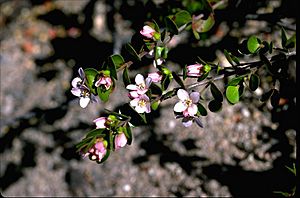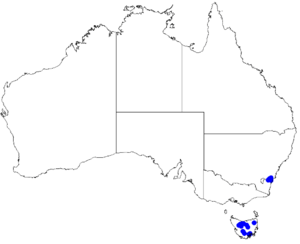Broad-leaved boronia facts for kids
Quick facts for kids Broad-leaved boronia |
|
|---|---|
 |
|
| Boronia rhomboidea in the Australian National Botanic Gardens | |
| Scientific classification | |
 |
|
| Occurrence data from Australasian Virtual Herbarium |
The Broad-leaved Boronia, also known as Boronia rhomboidea, is a special plant from the citrus family called Rutaceae. You can find it in two separate areas of Australia: New South Wales and Tasmania.
This plant is a woody shrub that stands upright and has many branches. Its leaves are simple, meaning they are not divided. They are shaped like a wide egg or are almost perfectly round. The Broad-leaved Boronia also has pretty flowers. They are white to pale pink and have four petals. These flowers grow in groups of up to three at the ends of the branches or where the upper leaves meet the stem.
What Does Broad-leaved Boronia Look Like?
Boronia rhomboidea is usually a woody shrub that grows straight up. It can reach about 1 m (3 ft) tall. Sometimes, it can also grow flat along the ground, which is called prostrate.
Its younger branches are covered with soft hairs. The leaves are simple and broadly egg-shaped or nearly round. They are about 5–15 mm (0.2–0.6 in) long and wide. Often, they have a reddish tint.
The flowers are white or pale pink. They grow alone or in groups of up to three. You can find them at the ends of branches or where leaves join the stem. Each flower has four sepals, which are like small leaves that protect the bud. These sepals are about 2.5–4.5 mm (0.1–0.2 in) long. The four petals are longer, about 5–8 mm (0.2–0.3 in). The flower also has eight stamens, which are the parts that produce pollen. These stamens are smooth, without hairs.
The part of the flower that receives pollen is called the stigma. It has four small parts and is a bit wider than the style, which connects the stigma to the ovary. This plant usually flowers from October to January. After flowering, it produces a smooth, dry fruit called a capsule. This capsule is about 3.5–4.5 mm (0.14–0.18 in) long and 2 mm (0.08 in) wide.
How Was Broad-leaved Boronia Named?
The plant Boronia rhomboidea was first officially described in 1905. A scientist named William Jackson Hooker wrote about it. He used a plant sample collected by Ronald Campbell Gunn from the "side of the Western Mountains." This description was published in a book called Icones Plantarum.
The second part of its scientific name, rhomboidea, comes from a Latin word. The word rhombus means a shape that looks like a diamond. This name likely refers to the shape of some part of the plant, perhaps its leaves or another feature.
Where Does Broad-leaved Boronia Live?
The Broad-leaved Boronia grows in wet, swampy areas called heaths. You can find it in two main regions of Australia.
In New South Wales, it grows on the Southern Tablelands. It is mostly found in the Budawang Range area. In Tasmania, you can find it in the highlands.

